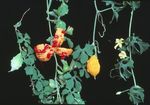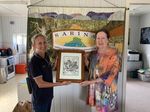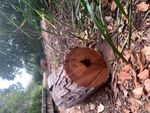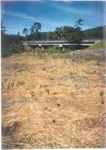SLCMA Catchment News 2021 - Sarina Landcare Catchment Management Association Inc.
←
→
Page content transcription
If your browser does not render page correctly, please read the page content below
Sarina Landcare Catchment Management Association Inc.
SLCMA Catchment News 2021
SLCMA News and events!
Friendly reminder that membership renewals are now due. The
membership fee remains at $10 per person annually, with all of the
great benefits. You are welcome to pay by internet banking, credit
card or cash. Contact us, to workout the best option for you.
July We are seeking Expressions of Interest for SLCMA Members who are interested in
volunteering to be on the SLCMA Management Committee. There will be some
Office: 101 Sarina Beach Rd vacancies at this year’s Annual General Meeting, scheduled for October. The SLCMA
Postal: PO Box 682 Management Committee helps to guide the direction of SLCMA and are well
Sarina, QLD, 4737
supported by our paid staff. If you are interested in nominating to be on the SLCMA
Phone: (07) 4956 1388
Website: Management Committee, please contact us for more information.
www.sarinalandcare.org.au Photos: contributed
Email:
admin@sarinalandcare.org.au
Farewell to the late Jack Langdon
It is with sadness that we share the news of the recent
Office opening passing of Jack Langdon—a supporter, motivator and avid
hours: Landcarer in the Sarina Catchment for more than 20 years.
9am-4pm weekdays. We would like to acknowledge Jack’s involvement and
support for Sarina Landcare over the years, which consisted
of various roles including volunteer, Management Committee
Other times by member, Revegetation Project Officer and Landcare
appointment, please member.
call 4956 1388 :) Jack was involved in many of Sarina Landcare’s milestones
and achievements including:
Staff
• the rehabilitation and transformation of the Plane Creek
Administration Officer Revegetation Site, since its in inception in 1995;
Kristy Thomsett
• the development & launch of the SICMA Strategy in
Coordinator 2002;
Saskia von Fahland
• construction of SLCMA Community Nursery in 2003
Nursery Officer
Susie Tomlinson In later years, we enjoyed working alongside Jack on a
Project Officer range of projects, while he was part of the Council Beach
Morgan Thomas Revegetation Team.
Call us for information: We would like to extend our
Weed management sincere condolences to Jack’s
family and friends.
Plant identification
Top: Plane Ck Reveg Site (1995),
Land management SLCMA Nursery (2003), Launch
FREE property visits of SICMA Strategy (2002) &
Land for Wildlife some fun at the Sarina Festival.
Volunteer opportunities:
* SLCMA Community Thank you Mackay Regional Council!
Volunteer Program, A huge thank you to Mackay Regional Council who Photo: M. Thomas
Wednesday, 9-12 noon. organised DH Slashing to remove a couple dead trees that
* Friends of the Sarina were posing a safety risk in the Sarina Community Native
Community Native Gardens, Gardens, recently.
Monday, 9-12noon.
The trees were removed and mulched with great care, and
Native plants available for some logs were the gardens to help provide additional habi-
purchase $3.30 each. tat for smaller species as most contained hollow centres. The
smaller logs have also been used as garden edging.
SLCMA Executive 20/21
Chair: Mark Evans With roughly 400 species in Australia that rely on hollows for
habitat who face continual pressure, why not try and recycle
Vice-chair: Lachlan McBride some of your old timber or logs to help them out! It can Hollow in log for wildlife
Treasurer: Kevin Plumb even encourage new wildlife to your garden for you to enjoy.
Secretary: Shirley Sidey
Executive members:
Sandy Evans
Artist feature
Karen May Our SLCMA Office is lucky to be dazzled with a variety of
artworks from local artists. Recently, we were kindly given
a lovely line drawing of the Sarina Inlet Trail, from and
drawn by Roni Boyle. Thank you Roni, ‘’it has gone straight
to the pool room’ :)
Page 1 SLCMA Catchment News 2021Sarina Community Nursery Volunteer Program
Our amazing volunteers have helped us to achieve a lot of tasks in and around the nursery again this month.
They were busy with the usual weeding, seeding, potting and chin wagging along with a little maintenance to the
nursery gate and building up a pathway in preparation for the summer floodway that emerges soon after rain.
Hopefully, we will be keeping our feet dry on our way to and from morning tea!
We had a very fruitful seed collecting outing to Hay Point which Photo: S. von Fahland
was well attended. We have lots of seed to be cleaned, stored or
sown in the coming weeks. It has been awesome to see some
new volunteers this month too. Welcome to Kain and Margaret.
We hope you enjoy your time with us.
If you would like to volunteer in your local community
and meet new people while learning about local native
plants and their propagation, come along to the SLCMA
Community Volunteer morning, every Wednesday, 9am to
12noon. SLCMA Community Volunteer Program is proudly Our volunteers enjoying some time out in the
supported by Mackay Regional Council, Natural Environment sun collecting seeds of local native species at
Levy. For more details contact SLCMA on 4956 1388. Hay Point Beach.
SLCMA Community Nursery ‘Plant of the Month’
This month’s ‘Plant of the Month’ is the Alexandra Palm (Archontophoenix alexandrae)
Family: Arecaceae
What is in a name? Archontophoenix from the Greek Photo: S. von Fahland
archontos meaning ruler or chieftain. Phoenix from the
Phoenix date palm—that is this genus is superior in
appearance to the common date palm; alexandrae is
named after Princess Alexandra of Denmark (1844-1925)
Form: Tall, slender, single-stemmed, feather palm
Leaves: Up to 4.5m long; pinnately divided with 60-80
pinnae per side. Dark green upper surface while lower
surface is covered in minute silver or grey scales.
Flower: Large panicle with many long, more or less
pendulous branchlets bearing both male and female
flowers. Flowers small, white to cream, any month.
Fruit: Turn from green to red when ripe: contain one
seed surrounded by a layer of thick interlocking fibres.
Habitat: Gullies, moist hillslopes and stream lines in
rainforest, and areas which are seasonally waterlogged. Flowers and seed of the Alexandra palm.
Distribution: Qld
Notes: Some Indigenous Australian communities cooked the fruits and also ate the growing tip of the plant. Leaf
sheaths were used to hold water and leaves to wrap food for cooking. Fruit eaten by many mammal and bird
species. Nectar eaten by the Eungella honey-eater. Larval food plant for some butterflies and moths.
The "Plant of the Month" is currently available from the SLCMA Community Nursery. Landcare members are
eligible to receive 1 free “Plant of the Month”, throughout that month. This and other native plant species are
also available for purchase at $3 each. All plants are grown from locally sourced seed in the SLCMA Community
Nursery by SLCMA staff and the SLCMA Volunteer team.
Friends of the Sarina Community Native Gardens
The Sarina Community Native Gardens are really looking
great!
Lovely to have some enthusiastic volunteers lending a
hand with planting, mulching, watering and weeding.
It’s a great way to warm up on cool morning with the sun
shining on you while you enjoy the outdoors with the
added benefit of some exercise.
If you would like to be involved, head down to our office
on Monday’s between 9 and 12noon.
This volunteer program was initiated through support by Photo: S. von Fahland
the Communities Environment Program.
Our legendary volunteers helping out this month for
Friends of the Garden.
SLCMA Catchment News 2021Weed feature: Balsam Pear Photo: A. Pearson
Balsam pear (Momordica charantia), sometimes referred to as
bitter melon is a widespread weed in northern Queensland
which has the potential to vigorously compete with crops and
native vegetation.
Originating in Asia, this plant has been widely grown for food
and medicinal purposes which has no escaped and begin to
degrade our natural ecosystems.
Balsam pear is a slender-stemmed, twining-climbing annual
vine with tendrils. All parts of the plant produce a strong,
Balsam pear habit, showing entire fruit, split
unpleasant smell. It has mid-green and soft textured leaves
fruit and exposed seeds covered in scarlet-red
which are deeply divided into 5-7 pointed lobes with scalloped fleshy aril.
margins.
Flowers are yellow with five petals about 2cm across, develop in leaf axils and all have a small green leaf-like
bract on the flower stalk. Fruit is fleshy, reddish-orange which hang and are covered in ridges and warty. The
fruits burst open at maturity and, peeling back to reveal small black seeds covered by a scarlet-red fleshy aril.
The plant can be spread by animals, birds and humans. It has the potential to invade sugarcane crops, rainforest
margins, creek bank and coastal communities, unmanaged land, roadside and gardens. It is particularly bad
within the Pioneer Valley in our area, smothering entire trees.
Small populations can be manually controlled, ensuring the roots and any stem fragments are removed from the
ground. Plant pieces should be bagged and put into the rubbish bin (not green waste), or hung in the sun off the
ground to prevent re-shooting. There is only currently one herbicide registered for the control and balsam pear.
Consult the DAF pest fact sheet for application rates depending on situation of infestations: https://
www.daf.qld.gov.au/__data/assets/pdf_file/0011/69491/balsam-pear.pdf
Frog Hotel Workshop Photo: M. Thomas
SLCMA had the pleasure of hosting a community Frog Hotel
Workshop on the 8th of July. Those who attended, let their
imaginations run free and had lots of fun creating their frog
hotels.... But why frog hotels?
Frogs play a significant role in the healthy functioning of our
ecosystems. They are what is called an indicator species, which
means if frog populations are decreasing, then an imbalance has
occurred within the ecosystem. Finished products of the Frog Hotel Workshop
Some common reasons as to why frog species are declining are Our first booking!
due to disease, invasive fish predation, competition from toad tadpoles, UV light, habitat dis-
turbance, and herbicides. Water quality due to human activities is also another cause to a de-
cline in frog populations, as detergents, chemicals, and heavy metals are washed into water-
ways when it rains, polluting them and impacting the wildlife that reside there.
Frogs also play a significant role in the food chain, as they are eaten by birds, snakes and lizards.
In return, frogs eat insects, other frogs, mice and even small birds! If frog populations continue to
decline, a serious imbalance in the food chain will occur.
What is a frog hotel? While frogs are most commonly associated with water, it’s important to
realise that this is not where most of them live. While ponds and water sources are breeding sites, frog hotels are
places for frogs to shelter, sleep and, in cooler weather, bunker down. In many areas of Austral-
ia, homeowners are regularly faced with green-tree frogs (and friends) hiding out and seeking shelter in laun-
dries, fence posts, bathrooms, door jambs and, the classic croaker location in Queensland and North-
ern Territory - toilets. This is the perfect opportunity to provide your frog families some extra habitat, so they
don’t start making their way indoors.
Will it work for all frogs? Like an exclusive nightclub, Frog Hotels are only suitable for tree frogs
(Litoria species). These arboreal amphibians have sticky toe pads that cling to the slippery surfaces which enable
them to climb into the Frog Hotel. For example, the Motorbike Frog (Litoria moorei) is a tree frog and is one of
many found around Australia.
How you can help:
• Build your own frog hotel is a fun, easy way to re-use materials from around the home such as pots, pvc
pipes & rocks. Check out our website for some simple instructions on how to build your own frog hotel.
• Become a Citizen Scientist—join the Australian Museum FrogID Project. A national project that is
helping us learn more about what is happening to Australia’s frogs, their diversity and distribution. Find out
more at https://www.frogid.net.au/
Thank you to Communities Environment Program for supporting the Frog Hotel Workshop. We are looking to
hold more workshops in the future, please let us know if you are interested in attending.
SLCMA Catchment News 2021What SLCMA Membership does for you !
A membership with SLCMA has many rewards:
Easy access to Natural Resource Management information and extension
Monthly newsletter, meeting minutes, progress and project reports
Office: 101 Sarina Beach Rd A vote on issues in your catchment
Postal: PO Box 682 A say in the types of projects applied for
Sarina, QLD, 4737
Phone: (07) 4956 1388 Up to 10 free local native seedlings/year from the SLCMA Community
Website: Nursery
www.sarinalandcare.org.au Invitations to Natural Resource Management field days and workshops
Email: Copy of the SLCMA Annual Report
admin@sarinalandcare.org.au
What do you call a girl with a frog in her hair?
Just for fun! Lily!
What do you call an ecosystem where the animals talk about current events?
A topical rainforest! A partnership for the
natural resource
Did you know I can cut down a tree by looking at it?
It's true, I saw it with my own eyes! management of
catchments in the
A man went to the doctor complaining that he kept seeing some Central Queensland
insect buzzing around him. Coast Bioregion:
The doctor just told him not to worry; it was just a bug that was
going around. Pioneer, Sarina &
Whitsunday
Catchments.
Containers for Change
SLCMA has registered with Containers for Change for
virtual donations and we are hoping that you will consider Find us on
using our identifier code — C10002138. We also welcome facebook
physical donations of eligible containers to our office, feel
free to contact us on 4956 1388, to arrange drop-off.
Thankyou to those who have donated your containers, so far we have raised
$274.20 —Thankyou :)
SLCMA is proudly supported by:
Page 4 SLCMA Catchment News 2021You can also read

























































